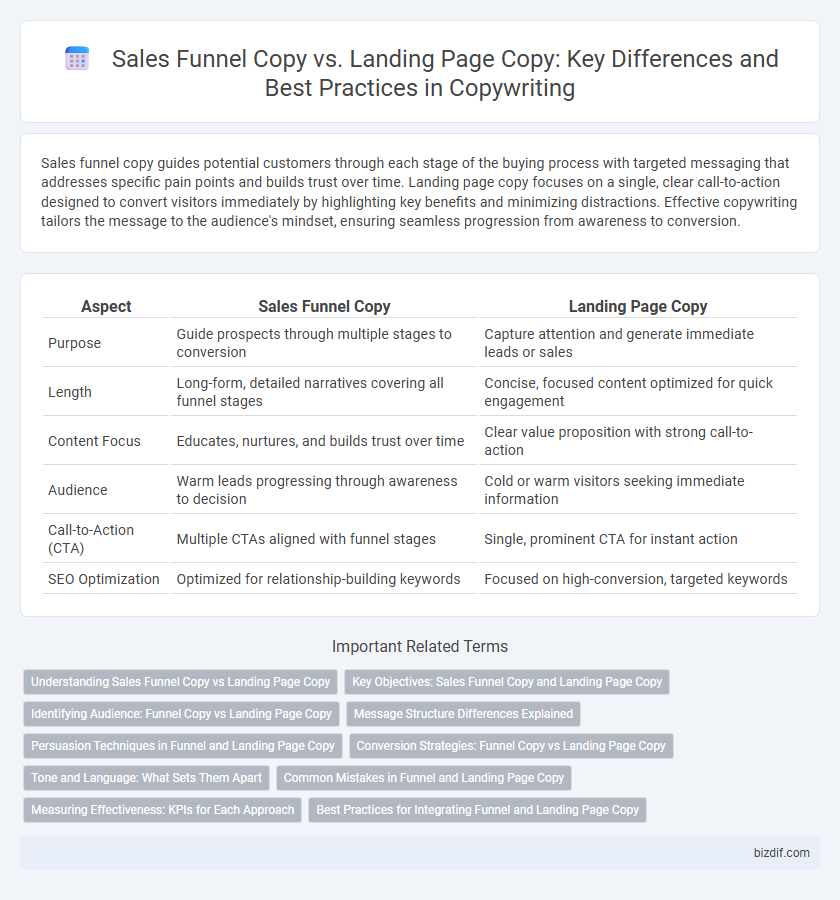Sales funnel copy guides potential customers through each stage of the buying process with targeted messaging that addresses specific pain points and builds trust over time. Landing page copy focuses on a single, clear call-to-action designed to convert visitors immediately by highlighting key benefits and minimizing distractions. Effective copywriting tailors the message to the audience's mindset, ensuring seamless progression from awareness to conversion.
Table of Comparison
| Aspect | Sales Funnel Copy | Landing Page Copy |
|---|---|---|
| Purpose | Guide prospects through multiple stages to conversion | Capture attention and generate immediate leads or sales |
| Length | Long-form, detailed narratives covering all funnel stages | Concise, focused content optimized for quick engagement |
| Content Focus | Educates, nurtures, and builds trust over time | Clear value proposition with strong call-to-action |
| Audience | Warm leads progressing through awareness to decision | Cold or warm visitors seeking immediate information |
| Call-to-Action (CTA) | Multiple CTAs aligned with funnel stages | Single, prominent CTA for instant action |
| SEO Optimization | Optimized for relationship-building keywords | Focused on high-conversion, targeted keywords |
Understanding Sales Funnel Copy vs Landing Page Copy
Sales funnel copy guides prospects through specific stages--awareness, consideration, and decision--using tailored messaging to nurture leads and drive conversions effectively. Landing page copy focuses on a single goal, often driving immediate actions like sign-ups or purchases, with concise, compelling content targeted at a defined audience. Understanding the distinction between these two types of copy is critical for creating persuasive marketing strategies that optimize user engagement and conversion rates.
Key Objectives: Sales Funnel Copy and Landing Page Copy
Sales funnel copy aims to guide prospects through multiple stages, nurturing leads by addressing pain points and building trust, ultimately driving conversions over time. Landing page copy focuses on a single, clear objective--capturing immediate user action such as sign-ups, purchases, or inquiries--by delivering concise, persuasive messaging tailored to a specific offer. Both types prioritize clarity and relevance but differ in scope, with sales funnel copy emphasizing relationship-building and landing page copy maximizing instant engagement.
Identifying Audience: Funnel Copy vs Landing Page Copy
Sales funnel copy targets segmented audience stages, tailoring messages to prospects' awareness and readiness to convert, ensuring personalized engagement. Landing page copy focuses on a specific, well-defined audience, addressing their immediate needs and driving a singular call-to-action. Understanding these distinctions in audience targeting enhances conversion rates and campaign effectiveness.
Message Structure Differences Explained
Sales funnel copy guides prospects through a sequential journey with targeted messages tailored to each stage--awareness, interest, decision, and action--using persuasive storytelling and addressing objections progressively. Landing page copy delivers a singular, focused message designed to capture attention and prompt an immediate conversion with concise headlines, benefits-driven content, and clear calls to action. The message structure in sales funnel copy is layered and adaptive, while landing page copy is direct and optimized for quick decision-making.
Persuasion Techniques in Funnel and Landing Page Copy
Sales funnel copy employs persuasive storytelling and gradual trust-building techniques to guide prospects through awareness, consideration, and decision stages, using tailored calls-to-action to nurture leads and increase conversions. Landing page copy focuses on clarity, urgency, and benefits-driven messaging to capture immediate attention and drive quick action, often utilizing strong headlines, social proof, and concise value propositions. Both leverage psychological triggers like scarcity, authority, and reciprocity, but funnel copy strategically layers these elements to maintain engagement across multiple touchpoints.
Conversion Strategies: Funnel Copy vs Landing Page Copy
Sales funnel copy strategically guides prospects through each stage of the buyer journey by addressing pain points, building trust, and gradually increasing commitment, which maximizes conversion rates over time. Landing page copy targets a specific action with a clear, concise value proposition and strong call-to-action, optimizing immediate conversion for a singular offer or product. Employing funnel copy supports nurturing leads through multiple touchpoints, whereas landing page copy excels in driving focused, high-impact conversions.
Tone and Language: What Sets Them Apart
Sales funnel copy employs persuasive, action-driven language designed to guide prospects through multiple stages, using personalized and conversational tones to build trust and urgency. Landing page copy prioritizes clarity and simplicity with concise, benefit-focused messaging aimed at capturing immediate attention and driving a specific call-to-action. The tone of sales funnel copy often adapts to audience engagement levels, while landing page copy maintains a consistent, direct voice to maximize conversion rates.
Common Mistakes in Funnel and Landing Page Copy
Common mistakes in sales funnel copy include overly complex messaging that confuses leads, lack of clear calls to action, and failure to address the target audience's pain points effectively. Landing page copy often suffers from generic headlines, insufficient benefits highlight, and neglect of trust elements like testimonials or guarantees. Optimizing both funnel and landing page copy with targeted, concise, and persuasive language significantly improves conversion rates.
Measuring Effectiveness: KPIs for Each Approach
Sales funnel copy effectiveness is measured through KPIs such as conversion rate, click-through rate, and customer acquisition cost, reflecting user progression at each stage of the funnel. Landing page copy success relies heavily on bounce rate, time on page, and lead generation rate to assess the immediate impact on visitor engagement and action. Tracking these specific KPIs enables marketers to optimize messaging strategies for improved sales outcomes and targeted audience response.
Best Practices for Integrating Funnel and Landing Page Copy
Sales funnel copy should strategically guide prospects through awareness, consideration, and decision stages by addressing their pain points with targeted messaging, while landing page copy must deliver a compelling value proposition and clear call-to-action that aligns with the funnel's intent. Integrating funnel and landing page copy involves ensuring consistency in tone, benefits, and user expectations to create a seamless transition that reduces bounce rates and increases conversions. Effective practices include using persuasive headlines, reinforcing trust signals like testimonials, and optimizing copy for relevancy based on traffic source and user behavior data.
Sales Funnel Copy vs Landing Page Copy Infographic

 bizdif.com
bizdif.com